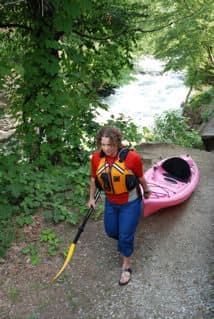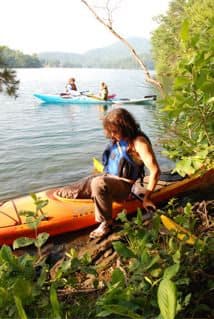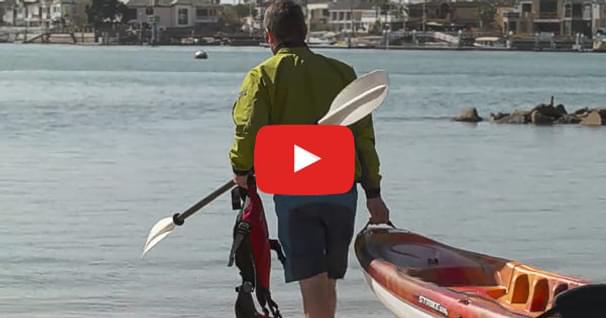Planning a Paddling Trip
In my opinion, the quote: "Failing to plan is planning to fail" is a bit dramatic as I do enjoy spontaneity and the flow of the present moment. However, I do think that planning for your kayak trip will make your experience more relaxing, more enjoyable and safer. The very basics you need for a great paddling trip are your kayak, your gear and enthusiasm, but before you head down to the water and push off I'd like to offer a few extra preparation tips that can help make your trip awesome!
As a kayak instructor my first piece of advice for trip planning is to take a paddling class. A half-day or full day of recreational kayak instruction will do wonders for your skills, your safety and your fun factor. Taking a class is not a prerequisite for getting out on the water, but getting instruction sooner rather than later is better as it tends to prevent the formation of bad habits. A good instructor can also share invaluable personal experience on trip planning and safety whether you're headed out for a short jaunt or a mutli-day trip.


TAHE 10'6 & 11'6 SUP-YAK Inflatables
2-in-1 Kayak & Paddle Board complete packages for single or tandem use.
My first tip on trip planning is know where you're launching, how to get there and how to get back. Going out for a short lake paddle is one of the easiest and simplest ways to enjoy your kayak and get outside until you get lost. You can get lost on your way to the lake and you can also get lost once you're in the water, even on smaller lakes. Research driving directions and times and after you launch and start paddling look back once in a while to make sure you'll remember how to get back! I remember the first time I went out and realized that if I didn't pay attention I could end up lost and paddling around a lot longer than I intended to get back to my car.
Carrying a map of the lake or river is also a good idea so that you can keep tabs on where you are. You may live close to a small lake and not have to worry about this, but if you're not familiar with the body of water that you're planning to paddle then bring a map and pay attention! A GPS is a popular accessory these days, but sometimes they can be unreliable so it's still a good idea to bring a map and have the old-school back-up. Just in case.
If you're planning a paddle down an easy-going river it's very important to know ahead of time where you're launching, taking out and how long it will take you to get from point A to point B. As a former raft guide I've been asked plenty of times if you end up at the same spot that you put in on the river. The answer is NO! At the end of your river paddle you will end up downstream from where you put in - maybe many miles downstream. If you want to paddle for a few hours, but you launch on a 10-mile river run, chances are you'll be out for a lot longer than you thought. Sometimes this is fine, but once you set out paddling only you can get yourself back to shore or to the take-out so you want to make sure that you have the stamina and energy for the length of the trip. Or make sure that the length of the trip fits your energy and stamina level. The same advice applies to longer flatwater paddling trips where you're traveling to different points to set up camp. Miscalculating your paddling time can take away from relaxation time.
Another note on paddling down rivers: Don't forget to factor in the shuttle driving time into your trip planning. Depending on access points this can add quite a bit of time onto your trip. Make sure you plan for that and research driving directions. Again, don't put all of your eggs in one basket and only rely on your GPS, especially when driving to rivers. I've had several friends follow their GPS to rivers only to find themselves at dead ends or dead ended into a creek on a logging road. Maps are still relevant and helpful!
When planning for overnight trips researching where your camp sites are and how many miles you must travel to get there is key. Knowing what time you want to arrive at camp is also key. You may want to arrive to set up camp at 4 p.m., but if you underestimate the distance you may end up setting up and cooking in the dark. Again, think about how you want to spend your time: Drinking a cool beverage in nice dry clothes on the beach watching the sunset OR paddling to camp in the dark? When planning your timeline remember that you're only as fast as your weakest paddler; if you know of someone who is slower than the rest of the group, plan your timing around them so that you don't leave anyone behind in the dark.
Knowing what kind of weather you'll be dealing with on your trip can make or break your experience. I've definitely left the house on my way to paddle at higher elevation thinking that it was going to be as warm as it was in my front yard. Not smart! Had I paid attention, planned better and brought more layers, my experience would have been much more fun! Check the weather before your trip, especially the morning of and in the area where you're paddling. Take things like elevation, if they're relevant into consideration. It may not be elevation you want to consider, but exposure to wind. If your house is surrounded by trees it's probably going to be a lot warmer when you're loading than it will be out on the lake.
Checking water temperature before you launch is also a good idea as it's important to dress not only for the temperature outside, but also for the water that will be splashing you. My rule of thumb is that it's better to have to take layers off than not have extras to put on when you're cold. For overnight camping trips, the weather will dictate what clothes to bring for the camp site and sleeping. Bringing rain gear and a tarp, even if the weather isn't calling for rain, is good planning. That way you'll be prepared and will have a communal dry space that's easy to set up at camp.
Checking the weather isn't all about what to wear on your trip, the weather patterns may also affect your timing. For instance, if you know it's going to be scorching hot and you don't want to be doing most of your paddling in the middle of the day, you may choose to go out in the early morning or late afternoon. If there's going to be more wind in the afternoon you may want to head out early. Or if the weather is suppose to clear in the afternoon you may want to wait. On overnight trips, checking times for sunrise and sunset are also helpful to keep track of when you want to get started and when you want to make it to the next camp.
A watch or some sort of timepiece is helpful in keeping you prepared. I'm not suggesting that you spend every 5 minutes looking at your watch. You want to relax, enjoy the scenery and get a break from your daily routine. That's great, but it's also important to keep track of time, especially if you're paddling later in the day. It's helpful if you're trying to get a workout too. I've definitely paddled hard and thought: "Wow I just paddled for 45 minutes straight!" Then realized it was only 15! Wishful thinking! And then there's the other side of that coin where you may get so wrapped up in the beauty and the flow of paddling that you paddle 45 minutes longer than you intended. It's good to be able to check the time when you need to. That will keep you from paddling in the dark unintentionally.
Planning your food and water needs is one of the most important aspects of good trip logistics, especially on weekend or multi-day trips. Even if you're going out for a few hours you want to bring at least a 27 ounce bottle of water and a granola bar. Staying hydrated with plain water helps your muscles and your joints function better and it increases your energy level. No one likes a paddling buddy who is grumpy because she's hungry. That's good enough reason to bring lots of food for yourself and some to share!
Good, efficient packing is part of good trip planning, especially for multi-day trips where you'll be carrying more food, water, camping gear, layers and accessories. Keep in mind that the more you pack the more your boat is going to weigh, the lower you'll sit in the water and the less responsive your kayak will be. Think of distributing the weight evenly when packing your boat. It's no fun if you're bow is loaded down and plowing into the water all day. Pack light while still bringing the essentials. I've been traveling and paddling for years and I still manage to pack too much sometimes. Remember that when you're camping you usually wear the same clothes over and over and that goes for gear too.
Another packing tip is to make sure that the things you'll want access to during your paddle are easily accessible! I know, sounds simple, but I have been guilty of burying something like my hat and having to pull over and unpack some stuff to get to it. Planning where you're going to put things in your boat will make your life easier. Carrying a 'day bag' separate from your other bags on overnights is a good way to do it. A day bag can include water, snacks, map, first aid (be sure you know how to use it), watch, sunglasses, hat, sunscreen, a few extra layers etc… Things that you may want access quickly and easily while you're paddling.
If you or someone in your group needs assistance, it's good to have researched the closest ranger station, road or the nearest place where you can get help. This is especially helpful if you're paddling in an area that you're not familiar with. A cell phone brought as a precautionary measure so that you can call someone if you need help is a great idea... as long as there's cell service where you're going. These days, smart phones have all kinds of apps that can probably help you with your trip planning, but it's also good to unplug and save the phone for emergency needs only.
To sum all of this up, your best tools for trip planning are common sense and mindfulness during the planning process. Pay attention to what you are doing, where you are going, and how long it will take you to get there and get back. Those are the basics to come back to. The list could go on beyond what I've mentioned in this article and it's good to do your own research. There are plenty of resources online, information at your local outfitter shop and in guide books. Enjoy your trip and be safe!
Related Articles
The Northern Forest Canoe Trail is an historic waterway spanning 740 miles from Old Forge, NY to Fort…
We all want to get out there and start having fun. But a little bit of trip planning can really help…
While down sizing the books in my den, I came across one of my many logbooks. I opened it up and began…
One of the best things about kayaking is that it's a healthy and fun activity to share with your whole…




